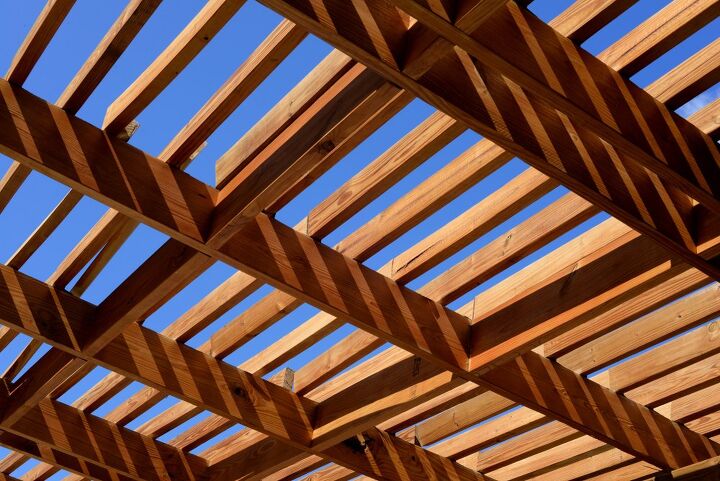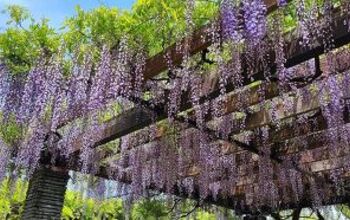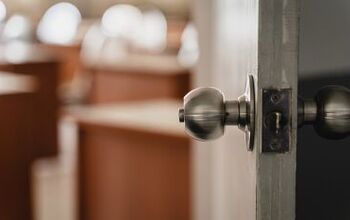Pergola Vs. Trellis: What Are The Major Differences?

As summer winds down, you may be looking for one final project to enjoy the last of the warm days in your backyard. Maybe you want to introduce more plant life in an interesting way. Or maybe you want to create a defined outdoor space to entertain friends and family.
If either of these sounds good to you, then you’re looking for a pergola or a trellis. But which one is which? These two often get confused.
Both pergolas and trellises can be freestanding or attached to a structure. The main difference is that a trellis, by definition, is built to support plants. A pergola is an open-sided structure with an open-rafter roof that offers partial shade, usually on a deck or patio. Climbing plants can be grown on a pergola, though that is not its main purpose.
Do You Need Landscaping Services?
Get free, zero-commitment quotes from pro contractors near you.

What is a Pergola?
A pergola is a structure with posts that support a flat roof. The sides of a pergola are open, and the roof contains beams of wood that allow partial light to stream through.
Pergolas can be freestanding or attached to a structure, usually the roof or side of a building, and they are larger than a trellis.
Pergolas have become increasingly popular in creating an outdoor room of sorts. They’re usually positioned near a grill, making it the perfect spot for parties and barbecues. Many people choose to hang string lights from the beams to create a cozy atmosphere for nighttime entertaining.
Because of the open-style roof, pergolas don’t offer full shade from the sun and weather elements. However, a removable cover—similar to a tarp—can be added for more shade and coverage. Another way to provide more shade would be to add latticework to the sides, making them less open.
For more decoration—and potential coverage from the elements—you can grow plants around the posts of a pergola. This is not necessary, however, as it is for a trellis.
What is a Trellis?
A trellis is a lattice structure built to support plants that climb, such as the vines of grapes or tomatoes or flowers like wisteria.
Unlike pergolas, trellises come in many different forms. They can be freestanding or attached to another structure. In addition, they can be either vertical or sloped. Many people think trellises can also be arch-shaped. However, that is something known as an arbor, which is not the same as a trellis.
A vertical trellis is often used to train young fruit trees. These types of trellises are known as espaliers, and they are attached to a building or fence. Another type of vertical trellis is the ornamental trellises often found in gardens. These can be secured directly to the ground or attached to a wall or fence.
Sloped trellises come in two forms: a lean-to trellis or an A-frame trellis. A lean-to trellis lets plants grow on an incline and can be shaped into a half arch. Other plants that need more shade can be put underneath a lean-to trellis. An A-frame trellis has two inclines that meet at a peak. Plants can be encouraged to climb on either side or up one side and down the other.
There are several types of freestanding trellises. A trellis planter box is a planter box with a trellis attached behind it. Column trellises are used for displaying plants in a pedestal-like fashion and can be used in or out of doors. A folding screen trellis looks reminiscent of a privacy screen made up of three panels.
Building Materials
Traditionally, both trellises and pergolas are made from wood. However, they can also be made of vinyl or metal.
Wood
Wood typically doesn’t fare well when exposed to the elements. Choosing the right wood for your pergola or trellis is important so you aren’t constantly replacing it. Because these structures both have contact with the ground, your choice of wood needs to be considered carefully.
Certain woods like cedar or redwood are rot-resistant and allow the structure to last longer. However, they tend to be on the pricier side.
Pressure-treated wood is another safe choice as it’s been manufactured to withstand outdoor elements. But the color isn’t terribly appealing, so you may be inclined to paint it which adds another element of upkeep to consider.
Vinyl
The benefit of a vinyl trellis or pergola is its weather resistance. It will last much longer than wood. However, vinyl can’t be painted. What you choose is what you get. Changing it means replacing the entire structure.
Metal
A metal pergola or trellis gives an industrial look. Like wood, metal can be finicky in weather. Over time, it may rust, so you have to treat it in order to protect it from the elements.
Cost of a Trellis
The cost of a trellis is determined by many factors, including materials, size, and whether or not you’re installing it yourself.
To get a trellis installed professionally, it can range anywhere in price from $350-$2,000. The average homeowner pays around $800 for a trellis installation.
By Size
Trellises come in a range of sizes to suit your needs. The chart below shows the price range of trellis installations based on their size.
| Trellis Size | Cost |
| 4 foot | $250-$550 |
| 6 foot | $350-$700 |
| 8 foot | $800-$2,000 |
| 10 foot | $1,200-$3,500 |
By Material
There are many different materials from which you can build a trellis. Here is a breakdown of the cost to install a trellis based on its material.
| Trellis Material | Cost |
| Stainless Steel | $350 – $450 |
| Iron | $400 – $600 |
| Metal | $500 – $625 |
| Plastic | $500 – $685 |
| Composite | $500 – $700 |
| PVC | $700 – $820 |
| Vinyl | $800 – $1,025 |
| Wood | $1,000 – $1,150 |
Cost of a Pergola
The cost of a pergola ranges from $700-$10,250. The average homeowners pay around $3,903. Just as with a trellis, the cost depends on various factors.
By Type
Pergolas come in a variety of styles. A standard pergola is like the type we describe above—posts and a slated roof, nothing extraordinary. A louvered pergola has a roof that can be opened or closed depending on the weather. A smart pergola has a roof that is controlled by a remote or smartphone. A retractable pergola features a roof that can be completely pulled back from the top.
| Type of Pergola | Average Cost |
| Standard | $30-$60 per square foot |
| Louvered | $20-$55 per square foot |
| Smart | $60-$65 per square foot |
| Retractable | $900-$3,000 or more total |
By Material
This chart shows the pricing of pergolas by building materials. These are the most common materials out of which pergolas are built.
| Pergola Material | Average Cost per Square Foot |
| Aluminum | $10-$30 |
| Redwood | $40-$50 |
| Cedar Wood | $25-$35 |
| Vinyl | $10-$30 |
For example, a 100 square foot aluminum pergola would cost between $1,000-$3,000.
By Size
Including the price of materials and installation, it can cost between $30-$60 per square foot to build a pergola. Specialty materials or customs designs can cost upwards of $100 per square foot.
| Pergola Size | Cost |
| 10×4 | $1,200-$2,400 |
| 10×10 | $3,000-$6,000 |
| 11×11 | $3,630-$7,260 |
| 12X12 | $4,320-$8,640 |
| 12×18 | $6,480-$12,960 |
| 10×14 | $4,200-$8,400 |
| 10×20 | $6,000-$12,000 |
DIY Kits
DIY pergola kits are available for purchase and save the additional costs of labor. These kits range in price from $600 to $7,500 or more. The range of costs for a kit is based on the same factors as if you were building it from scratch.
Related Questions
There is a lot to think about when deciding between a trellis and a pergola. We covered many key points, but you may still have questions. Below are things other people wondered relating to pergolas and trellises.
What’s the difference between lattice and trellis?A trellis is a structure while a lattice is a pattern. Trellises use the lattice pattern to encourage plants to climb. The lattice pattern is used across many mediums—from clothing to woodwork to weaving. On the other hand, a trellis wouldn’t be a trellis without a lattice.
What do you call a pergola with a roof?If the roof of a free-standing pergola is completely covered, it is often referred to as a pavilion or a gazebo. A solid roof can be added to a pergola, but the difference is that roof is removable whereas a pavilion roof is not.
Does a pergola add value to your home?Because of the rise in popularity of outdoor living, pergolas are a much sought-after feature for home buyers. Many people will pay top dollar for trendy features they don’t have to add themselves. Any backyard upgrade—pergolas included—can end up increasing your return of investment (ROI) by 50%-80%.
What are the best climbing plants for a trellis?Some of the best climbing flowering plants for a trellis include roses, clematis, wisteria, bougainvillea, and ivy. Some of the best climbing fruiting vines include grapes, beans, tomatoes, cucumbers, and squash.
Do You Need Landscaping Services?
Get free, zero-commitment quotes from pro contractors near you.

Summing It Up
Both trellises and pergolas add beauty to your outdoor spaces. Many building materials are available for either option, and the cost to build and/or install ranges just as widely.
For those that want a structure specifically designed to support plants, a trellis is the way to go.
If you want to create a defined outdoor area that gives partial protection from the elements, then a pergola is for you.
Because pergolas tend to be bigger, they usually cost more than trellises. Pergolas can range anywhere in price from $700-$10,250, while trellises cost between $250-$3,500.

Brigid Levi is a wife, mother, and freelance writer who enjoys a good DIY project and creating beautiful spaces within her home. From cleaning and organization hacks to home decor ideas, she loves helping people in their quest to turn a house into a home. Her hobbies include pretending to be Joanna Gaines while updating her home with her husband and performing in local theater productions.
More by Brigid Levi



























